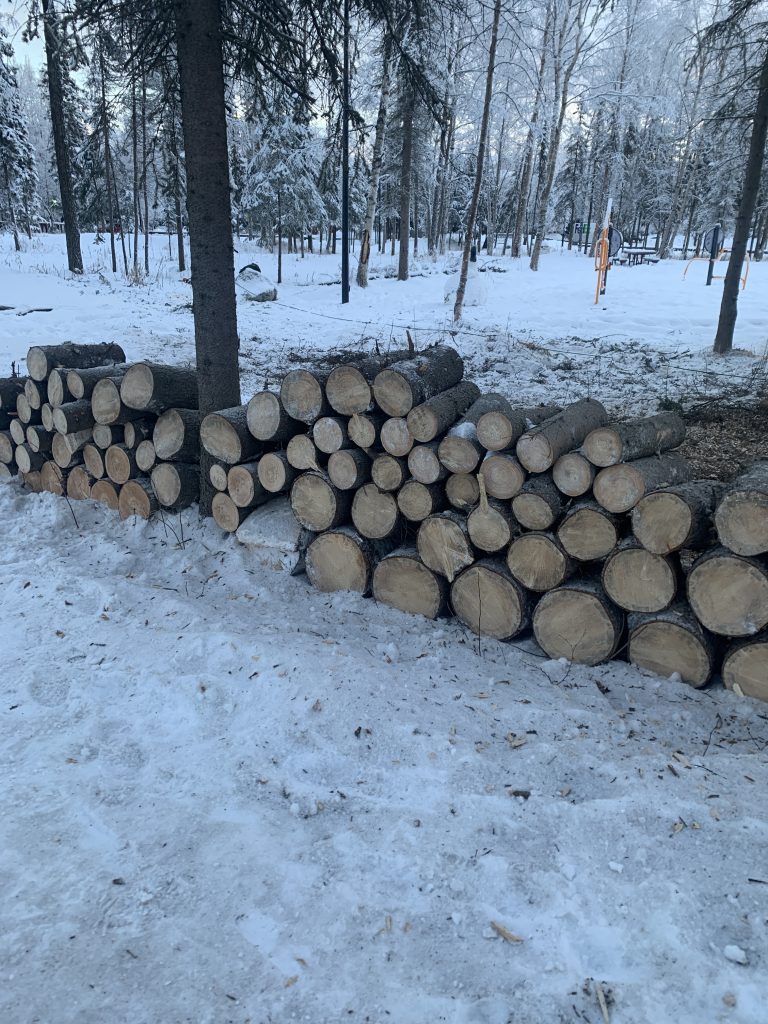Despite the dark and cold conditions of winter in Alaska, this dormancy period for trees brings about unique opportunities. Year to year, the challenges may outweigh the advantages, but for most landscape ornamentals, winter can be a valuable time for maintenance. In this post, we’ll explore the benefits of tree removal and care in winter, as well as some considerations to take.
Enhanced Visibility
The stripped-down simplicity of winter reveals the intricate structure of trees, unobscured by foliage. Arborists can conduct thorough assessments, identifying structural weaknesses, deadwood, or diseased limbs that require removal. This heightened visibility facilitates precision pruning, ensuring that the tree’s integrity and aesthetics are preserved or enhanced. Moreover, the absence of leaves allows for better light penetration, enabling arborists to identify potential issues such as crossing branches or overcrowded growth more easily. For particularly mature and/or overgrown trees and shrubs, late winter is the perfect time to prune if they’re not buried in snow.
Disease and Pest Management
Winter tree removal and pruning serve as proactive measures against diseases and pests. Winter is not only a dormancy period for trees and shrubs, but most pests and fungal pathogens too. By removing diseased or infested branches during dormancy, the risk of pathogens spreading to healthy parts of the tree or neighboring trees is significantly reduced. Moreover, disrupting pest habitats in winter can interrupt their life cycles, curbing population growth before they become a menace in warmer months. Removing and/or pruning trees in winter allows for the removal of fungal or insect-infested wood (i.e. spruce bark beetles), preventing further spread of pests and diseases within the tree.
Storm Preparedness
Winter storms (also known as “winter weather advisories” here in Alaska) pose significant threats to trees, especially those burdened with weak or overextended branches. Preemptive removal of hazardous limbs before such conditions can mitigate potential damage from heavy snow or ice accumulation. Fortifying your trees against inclement weather can safeguard your property from the costly repercussions of fallen branches and power outages. Furthermore, selective pruning of canopy branches can reduce wind resistance and snow load, minimizing the risk of branch breakage and property damage during storms.
Stimulating Growth and Regeneration
Strategic pruning and removal of select branches in winter can serve as a catalyst for growth and regeneration come springtime. By eliminating dead or overgrown limbs, the tree’s energy is redirected towards healthy growth, resulting in improved overall health. Additionally, late winter pruning can improve compartmentalization, as the pressure from pathogens is reduced. Furthermore, thinning out overcrowded branches allows for better air circulation and sunlight penetration, fostering optimal conditions for new growth and rejuvenation.
Aesthetics
While winter may strip the landscape of vibrant colors, well-maintained trees can still command attention with their sculptural allure. Thoughtful pruning and selective removal of branches accentuate a tree’s silhouette and architectural features, enhancing its visual appeal amidst the winter landscape. By investing in winter tree care, you can ensure that your outdoor space remains captivating year-round. Additionally, strategic pruning can promote symmetry and balance, creating harmonious compositions that enhance the overall aesthetic of the landscape.
Cost
Winter can make the cost of removals and pruning cheaper. Less time spent identifying branches to prune without the hindrance of foliage can make the job not only faster, but easier. There’s also less biomass to be hauled away, further reducing cost.
Hindrances and Considerations: The Challenges
Despite all the different reasons for which tree and shrub maintenance in winter becomes easier, the challenges provided by some landscapes can cause a project to be more time consuming and expensive. It’s essential to acknowledge and address potential hindrances and considerations associated with the season. Communication with an Arborist can provide insight on whether your proposed project and goals are feasible in the winter. Things to consider:
a. Limited Access: Snow accumulation and icy roads may restrict access to tree removal sites. Transportation of heavy equipment and machinery may be hindered, causing delays in scheduled tree maintenance projects. This makes the process of getting an estimate particularly important, as meeting with an arborist can help with ensuring restrictions are identified.
b. Reduced Availability of Services: For us in Alaska, winter coincides with a decrease in the availability of some tree care services and companies. Most tree services slow down or stop working entirely. Frozen (and/or snow covered) ground makes stump removal unfeasible. Winter weather advisories and heavy snowfall may result in priority having to be placed on emergency tree removals, resulting in less availability for routine maintenance tasks. Additionally, here at Gage, we take on winter services like holiday lighting and snow removal, which can impact availability. But when conditions allow, services can resume. Normally in January and February as the days get longer and we’re through the coldest weather. Planning winter tree removal or pruning projects well in advance will ensure your project can be done.
c. Limited Tree Assessment: While winter’s bare branches provide enhanced visibility for tree assessment, certain structural defects may be more difficult to identify during this season, like the presence of fungal pathogens. Snow accumulation or ice buildup can obscure branches or conceal potential hazards, making it challenging to conduct thorough inspections.
Conclusion
There are certainly both advantages and challenges posed by winter when it comes to tree care in Alaska. Maintenance of landscape becomes less of a priority (or even a thought) but can help alleviate the stress of what feels like a short window of opportunity in summer. It feels all too real that our summer isn’t long enough to get all projects done.
When in doubt, having an Arborist come out and assess the site and trees/shrubs for your projects is simple and can help determine ideal timing. With careful planning and execution, you can ensure that your trees thrive year-round, enhancing the beauty and value of your property for generations to come.
